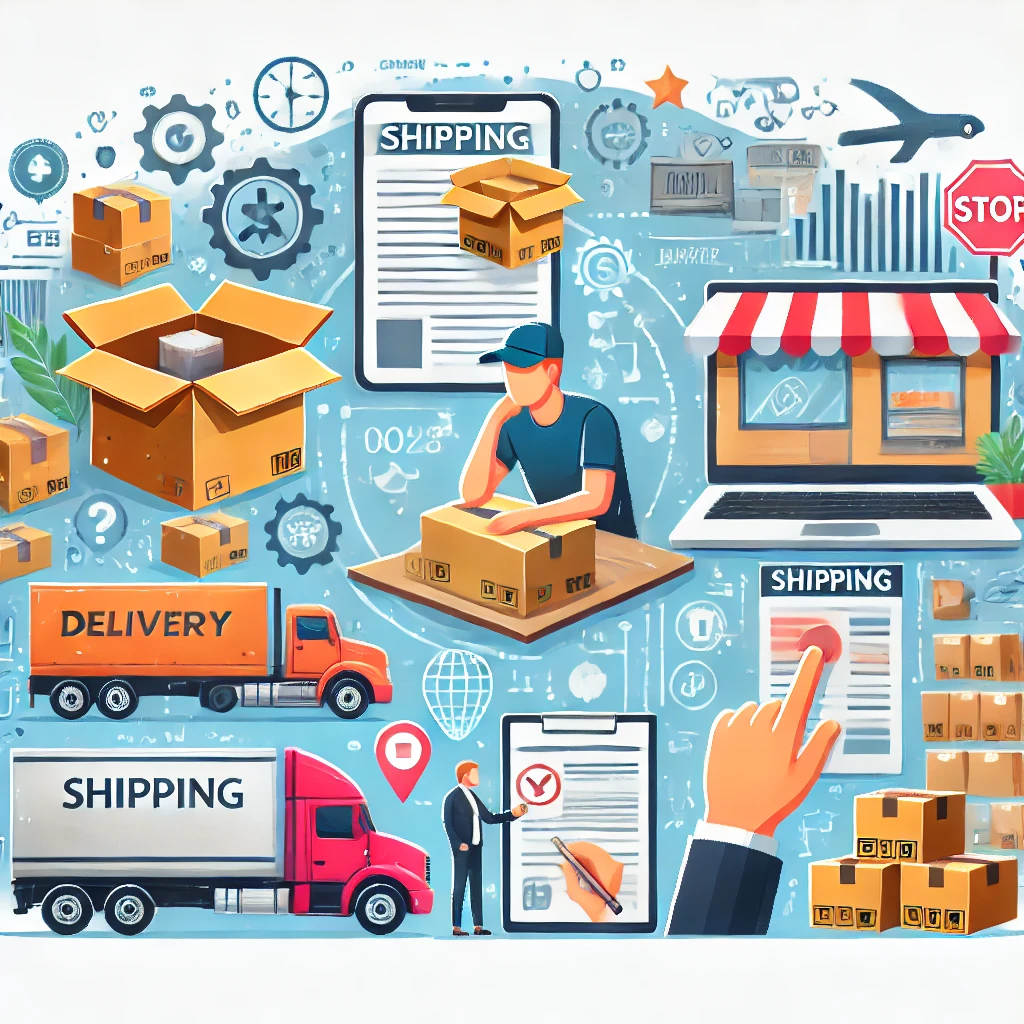Mastering E-commerce Shipping Costs: Strategies for Online Retailers

Introduction
Shipping is a critical component of the e-commerce experience, directly impacting both customer satisfaction and business profitability. The challenge lies in balancing cost-effectiveness with meeting customer expectations for fast and affordable delivery. Let’s dive into the world of e-commerce shipping and explore how to master this crucial aspect of online retail.
Understanding E-commerce Shipping Costs
E-commerce shipping costs encompass more than just the fee paid to carriers. They include:
- Carrier Fees: The base cost charged by shipping companies
- Packaging Materials: Boxes, envelopes, padding, tape, etc.
- Handling Costs: Labor involved in packing and processing orders
- Insurance: Protection against lost or damaged packages
- Return Shipping: Costs associated with product returns
These costs can significantly impact profit margins, making it crucial for e-commerce businesses to have a clear understanding of their total shipping expenses.

Unique Challenges of E-commerce Shipping
E-commerce businesses face several unique shipping challenges:
- Varied Product Sizes and Weights: Unlike traditional retail, e-commerce often deals with a wide range of products, each with different shipping requirements.
- Customer Expectations for Fast and Free Shipping: With giants like Amazon setting high standards, customers increasingly expect quick and free delivery.
- International Shipping Complexities: Cross-border e-commerce introduces additional challenges like customs, duties, and varying regulations.
- Returns Management: E-commerce typically sees higher return rates than brick-and-mortar retail, adding to shipping costs.
Best Shipping Practices for E-commerce
- Offering Multiple Shipping Options
- Provide choices ranging from economy to express shipping
- Use Linbis to automatically display the most cost-effective options at checkout
- Implementing Real-Time Shipping Rates
- Integrate carrier APIs to show accurate, up-to-date shipping costs
- Linbis can help automate this process, pulling in real-time rates from multiple carriers
- Using Flat Rate Shipping for Certain Products
- Simplifies shipping for customers
- Can be profitable for items within a specific weight and size range
- Providing Free Shipping Thresholds
- Encourages larger orders
- Set the threshold high enough to offset shipping costs
Optimizing Shipping Costs for Small E-commerce Businesses
Small e-commerce businesses can employ several strategies to optimize shipping costs:
- Negotiating Rates with Carriers
- Even smaller businesses can often secure discounts
- Consider consolidating shipping with fewer carriers for better rates
- Leveraging Shipping Software
- Use platforms like Linbis to compare rates and automate shipping processes
- Take advantage of discounted rates offered through shipping platforms
- Choosing the Right Packaging
- Use appropriate-sized packaging to avoid dimensional weight charges
- Consider investing in custom packaging for brand consistency and optimal protection
- Considering Outsourcing Fulfillment
- Third-party logistics (3PL) providers can offer economies of scale
- Evaluate if the cost savings and efficiency gains outweigh the fees
Advanced E-commerce Shipping Strategies
- Zone Skipping for Large Volume Shippers
- Transport packages to a distribution center closer to the final destination
- Can significantly reduce costs for high-volume shippers
- Hybrid Shipping Services
- Utilize services like UPS SurePost or FedEx SmartPost
- Combines the strengths of different carriers for cost-effective delivery
- Implementing a Distributed Inventory Model
- Store inventory in multiple locations to reduce shipping distances
- Linbis can help manage inventory across multiple warehouses and optimize order routing
- Using Predictive Analytics for Shipping Optimization
- Leverage data to forecast shipping trends and optimize inventory placement
- Linbis provides advanced analytics to help make data-driven decisions
Managing International Shipping for E-commerce
International shipping presents unique challenges and opportunities:
- Understanding Customs and Duties
- Clearly communicate potential additional costs to customers
- Consider using DDP (Delivered Duty Paid) shipping to simplify the process for customers
- Strategies for Reducing International Shipping Costs
- Use consolidation services for multiple orders to the same region
- Optimize packaging to minimize dimensional weight charges
- Partnering with Global Shipping Providers
- Leverage the expertise and networks of international shipping specialists
- Linbis can help integrate with global carriers and manage international shipments
Technology Solutions for E-commerce Shipping
Leveraging technology is crucial for efficient e-commerce shipping:
- Shipping Rate Comparison Tools
- Automatically compare rates across carriers
- Linbis offers built-in rate comparison features
- Order Management Systems
- Streamline the entire order fulfillment process
- Integrate with your e-commerce platform for seamless operations
- Automated Label Printing and Tracking
- Save time and reduce errors in the shipping process
- Provide customers with real-time tracking information
Measuring and Improving Shipping Performance
Key Performance Indicators (KPIs) for e-commerce shipping include:
- Average Shipping Cost per Order
- On-Time Delivery Rate
- Shipping Cost as a Percentage of Order Value
- Return Rate and Cost
Linbis provides comprehensive analytics to track these KPIs and identify areas for improvement.
How Linbis Enhances E-commerce Shipping Efficiency
Linbis offers a suite of tools designed to optimize e-commerce shipping:
- Multi-Carrier Rate Comparison: Automatically compare rates across carriers to find the best option for each shipment.
- Real-Time Shipping Calculations: Display accurate shipping costs to customers at checkout.
- Automated Order Routing: Determine the most cost-effective fulfillment location for each order.
- Returns Management: Streamline the returns process to minimize costs and improve customer satisfaction.
- Analytics and Reporting: Gain insights into shipping performance and identify optimization opportunities.
Case Study: An online fashion retailer implemented Linbis’s shipping optimization tools and saw a 25% reduction in average shipping costs within six months, while also improving delivery times.
Future Trends in E-commerce Shipping
As you optimize your current shipping strategies, keep an eye on these emerging trends:
- Same-Day and Instant Delivery Options
- Growing customer demand for ultra-fast shipping
- Potential for local fulfillment centers and partnerships with last-mile delivery services
- Sustainable Shipping Practices
- Increasing focus on eco-friendly packaging and carbon-neutral shipping options
- Potential for new pricing models based on environmental impact
- The Role of AI and Machine Learning in Shipping Optimization
- More accurate delivery time predictions
- Advanced route optimization and carrier selection
- Drone and Autonomous Vehicle Deliveries
- Potential for significant cost reductions in last-mile delivery
- Regulatory challenges to overcome
Conclusion
Mastering e-commerce shipping costs is an ongoing process that requires a combination of strategic planning, technological leverage, and continuous optimization. By implementing the strategies outlined in this guide and utilizing advanced tools like those offered by Linbis, e-commerce businesses can significantly enhance their shipping efficiency and competitiveness.
Remember, efficient shipping isn’t just about cutting costs—it’s about creating a positive customer experience that drives loyalty and repeat business. As you refine your shipping strategies, always keep the customer experience at the forefront of your decisions.
Are you ready to take your e-commerce shipping to the next level? Explore how Linbis can provide the tools and insights you need to optimize your shipping operations, reduce costs, and delight your customers. In the fast-paced world of e-commerce, staying ahead in shipping can give you the competitive edge you need to succeed.
